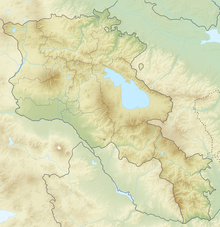Washing up
Wernaschen ( Armenian Վերնաշեն Wernaschen ), other romanization Vernaschen , old name Srkoghovk , until 1946 Azerbaijani Başkənd ( Baschkend ), is a village and a rural community ( hamaynkner ) with around 1300 inhabitants in the southern Armenian province of Wajoz Dzor north of the provincial capital Jeghegnadzor . The Gladzor Museum is dedicated to the history and importance of the medieval university of the same name, which was probably located in the nearby former Tanahat monastery .
location
Coordinates: 39 ° 47 ′ 38 ″ N , 45 ° 21 ′ 48 ″ E
Wernaschen is located at an altitude of 1479 meters on the slope of a hill five kilometers north of Yeghegnadzor. A road leads from the center of the provincial capital first through the suburb of Gladzor and continues uphill through Wernaschen. On the northern outskirts of the village, the single-lane asphalt road turns south-east, after five kilometers it reaches the former Tanahat monastery and ends three kilometers further at a pilgrimage destination for Armenian Christians, the church of the former Arkaz monastery ( Arkazi Surb Khach ).
The nine kilometer long road and the shorter footpath to the Spitakavor monastery church in the north in the mountains and further above to the 13th century fortress Proschaberd (Boloraberd) begins at the Gladzor Museum .
Townscape
According to official statistics from 2008, Wernaschen had 1,312 inhabitants. In 2012, the same number of inhabitants was 1318. Wernaschen is one of 41 rural communities in the province. The Armenian inhabitants came from the north-western Iranian region of Salamas around 1829 .
The town houses and farms in Wernaschen are surrounded by gardens with a dense tree population. Due to the loose development, Gladzor and Wernaschen have largely grown together along the connecting road. A fertile strip of fruit trees and small vegetable fields stretches from the valley of the Arpa river , in which Yeghegnadsor is located, to the altitude of Wernaschen, which in summer stands out like an oasis from the brown, grass-covered slopes of the surroundings.
There is a local bus service with Yeghegnadzor and two to three grocery stores along the only street.
Gladzor Museum
The place is known for the Gladzor Museum, which was set up in the former Surb Hakob Church from the 17th century. The museum building is a three-aisled basilica made of roughly hewn tufa blocks, some of which come from an older building. The three naves divided by massive rows of pillars are covered by a wide saddle roof, as is typical of southern Armenian church buildings of this time. The University of Gladzor was founded in 1282 when the south of what is now Armenia was largely independent under the princes of the Orbelian and Proschian families. One of the founders was the architect, sculptor and illuminator Momik . Until it was closed in 1338, it provided far-reaching impulses for Armenian religious and philosophical thought. She took a leading position in the self-assertion of the Armenian Apostolic Church against the Roman Catholic missionaries who wanted to submit Armenia to the Pope.
Students came to Gladzor from all Armenian settlement areas including Cilicia . Some of the 350 university graduates have been handed down by name. The training program, which lasted seven to eight years, comprised the classic seven subjects , with the three subjects (Latin: trivium ) logic , grammar and rhetoric being taught first, followed by the four subjects ( quadrivium ) arithmetic , geometry , music and astronomy . Miniature painting , calligraphy and sculpture also formed a focus . Unrest and anarchic conditions as a result of the quarrels between the Mongolian Ilkhan people led to the closure of the university. The philosopher Hovhannes Vorotnetsi (1315-1388 / 98) led after 1338 briefly teaching in the monastery Vorotnavank in the present province of Syunik further before joining the University of the monastery Tatev founded, which lasted until the 1434th
The museum displays copies of old manuscripts, maps and photos from various monasteries and educational institutions in the country. The original manuscripts are in Matenadaran in Yerevan . The building was restored in 1984, after the 700th anniversary of Gladzor University, which took place in 1982 near the ruins of Tanahat Monastery , and turned into a museum. It is open every day except Mondays from 10:00 a.m. to 4:00 p.m.
Web links
- Rick Ney: Vayot's Dzor. (PDF; 1.7 MB) TourArmenia, 2009, p. 14
- Brady Kiesling: Rediscovering Armenia Guidebook - Vayots Dzor Marz. 2005 (at Armeniapedia)
Individual evidence
- ↑ RA Vayots Dzor Marz. (PDF; 165 kB) 2008, armstat.am
- ↑ RA Vayots Dzor Marz. (PDF; 255 kB) 2012, armstat.am
- ↑ RA Vayots Dzor Marz. (PDF; 208 kB) armstat.am
- ↑ Sen Arevschatian: Armenian Philosophy in the Middle Ages. In: Armenia. Rediscovery of an old cultural landscape. (Exhibition catalog) Museum Bochum 1995, p. 224
- ^ Gladzor University Historic-Cultural Preserve-Museum. Armenian Heritage
- ↑ Rick Ney, p. 14


